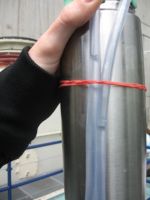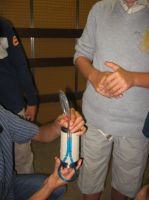Session 6 (optional): Pressure of the air if you have a large height difference
Objective 1: Demonstrate that air pressure varies in function of the height
Explanation
This experiment is very interesting because it will show that, although we don’t feel it, the pressure of the air varies depending of the altitude. This experiment is optional because you need to have at least five floors ( 15 m) of height to measure a difference. If it is not the case in your schools but some of your students live in high-rise flats for example, you can always ask them to do it, make a film, and bring it back to school.
Material:
- Empty plastic bottle as rigid as possible, not necessary transparent.
- If the bottle is not rigid the experiment does not work.
- Play dough
- Transparent plastic flexible tube 5 or 6 mm diameter
- Water, if possible with a little bit of food colouring.
- Play dough
Maximum duration:
45 minutes
Main question to be asked:
When you will change altitude, going up or going down, ask your student how the air outside the bottle will push with respect to the air within the bottle
Introduction/Starters
What happens to your ears when you take the plane or when driving fast down in a tunnel or going up a mountain?
Main activities
NB: This experiments works well but needs a little bit of practice before to do it.
- Take a transparent plastic flexible tube 5 or 6 mm diameter, 40 cm long and fill 15 cm of the tube with coloured water
- Now the most difficult part of the experiment is to trap the air at the pressure of the altitude where you are in your plastic bottle, to do this you need to close the aperture of the bottle around the plastic tube with play dough. This needs at least two persons: one to fill with the play dough, the other to keep the tube full of water.
- Then you are ready to go up or down, the easiest is to perform this experiments in a lift
- With younger children, observe the evolution of the pressure going down and up. Discuss with them the difference of pressure within the bottle and the air from outside pushing less going up.
- With older students you can quantify the variation of the water position going up and down
- You can also “trick” your students and give to one of them a very soft plastic bottle with a thin wall and do the same experiments. In this case the air will be a bit pressurised from outside and the difference of pressure will be smaller than for a rigid bottle. Ask them to explain the difference between the two cases (soft and rigid bottle).
Conclusion/Plenary
When going to higher altitude the mass of air above us decreases and consequently the pressure decreases.
If this variation of pressure is fast we can feel it on our ears.
If we take the air in a closed bottle at high altitude take it to a lower altitude, the pressure of the air in the closed bottle will be the pressure at high altitude, thus lower. Going down, the pressure around the bottle is higher and the soft plastic bottle will be crushed.













